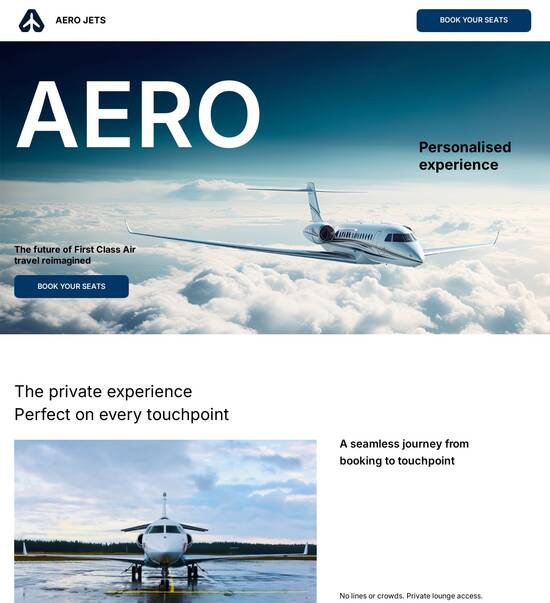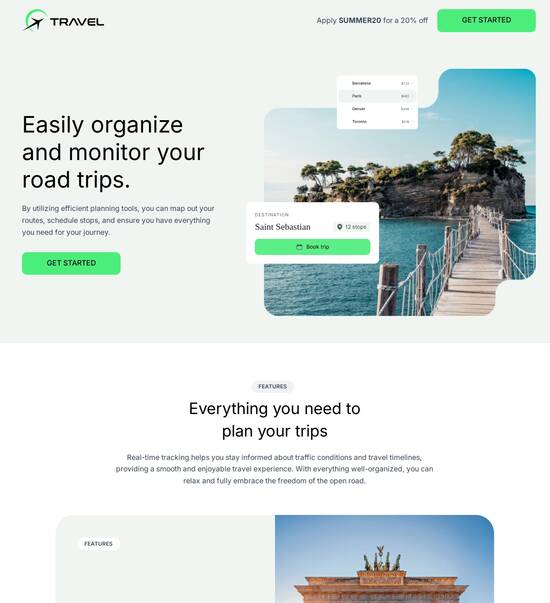
HTML page templates optimized for Huawei MediaPad
Use TemplateAbout template
Transform your customer experience with HTML page templates optimized for Huawei MediaPad. Make your landing page accessible on any device.
Recommended templates

Easy to build without coding
With the intuitive drag-and-drop builder, anyone on your team can create high-converting pages without any knowledge of code or design. Make enhancements to your landing page with custom widgets using Javascript, HTML/CSS, or third-party scripts.

Multiple layouts for any industry and goal
Select from 500+ landing page layouts built to boost conversions across industry-specific scenarios. Customize them by adjusting fonts, adding images, and generating on-brand content with the AI assistant. Quickly scale with Instablocks® and Global Blocks that you can save, reuse, and update globally.

Loads fast and looks polished on any device
Every template is responsive, which means they present professionally on any device and load blazingly fast with our Thor Render Engine. You can also power them up with Google AMP technology to deliver an unparalleled mobile experience and drive higher conversions.

Robust analytics & experimentation
Get real-time updates and reporting across all your devices, showing the number of visitors, conversions, cost-per-visitor, and cost-per-lead. Launch AI-powered experiments, run A/B tests, and use heatmaps to analyze user behavior, then optimize your landing page to maximize conversions.







Easy to build without coding
With the intuitive drag-and-drop builder, anyone on your team can create high-converting pages without any knowledge of code or design. Make enhancements to your landing page with custom widgets using Javascript, HTML/CSS, or third-party scripts.
Multiple layouts for any industry and goal
Select from 500+ landing page layouts built to boost conversions across industry-specific scenarios. Customize them by adjusting fonts, adding images, and generating on-brand content with the AI assistant. Quickly scale with Instablocks® and Global Blocks that you can save, reuse, and update globally.
Loads fast and looks polished on any device
Every template is responsive, which means they present professionally on any device and load blazingly fast with our Thor Render Engine.
Robust analytics & experimentation
Get real-time updates and reporting across all your devices, showing the number of visitors, conversions, cost-per-visitor, and cost-per-lead. Launch AI-powered experiments, run A/B tests, and use heatmaps to analyze user behavior, then optimize your landing page to maximize conversions.
All the features you need to build lead-generating landing pages
Explore more featuresLearn how to build top-performing landing pages for any goal
FAQs
Leading the way in building high-performing landing pages





Ultimate guide to using Instapage for optimizing your landing pages
Creating effective landing pages is crucial for business success in digital marketing. Instapage, an all-in-one landing page and Conversion Rate Optimization (CRO) platform, equips marketers with every tool needed to enhance campaign performance, ensuring they maximize their ROI effectively. This guide will walk you through the step-by-step process of utilizing Instapage to optimize your landing pages and improve conversion rates for your target audience.
Step 1: Choosing the right template
Instapage offers over 100 pre-designed, high-converting templates that cater to various business needs. To kickstart your landing page creation:
- Select a template suitable for your industry: Templates are categorized by industry, ensuring relevance to your audience.
- Customize the template: Use the intuitive drag-and-drop builder to modify images, text, and layouts without any coding experience.
- Add lead generation elements: Incorporate forms or CTA buttons that align with your campaign goals.
Step 2: Optimizing your landing page for conversions
To enhance the performance of your landing page, consider the following optimization techniques:
- A/B Testing: Utilize Instapage’s built-in A/B testing feature to compare different versions of your page and identify which elements drive more conversions.
- Analytics Dashboard: Monitor key metrics such as visitor behavior and conversion rates through Instapage's analytics tools to make informed decisions.
- Heatmaps: Use detailed heatmaps to understand how users interact with your page, allowing you to make data-driven adjustments.
Step 3: Personalizing the user experience
Personalization can significantly impact conversion rates. Here's how to tailor your landing pages:
- Dynamic text replacement: Customize messages based on user source or behavior, ensuring relevance and increasing engagement.
- AdMaps: Align specific ads with corresponding landing pages, improving user experience and conversion likelihood.
- Audience-level metrics: Track performance metrics by audience segments to refine your marketing efforts.
By following these steps and effectively utilizing Instapage's features, marketers can create high-performing landing pages that truly resonate with their audience.
In conclusion, optimizing your landing pages with Instapage is not just about aesthetics; it involves strategic planning and detailed execution. Start implementing these strategies today for a more powerful approach to digital marketing.
Ready to elevate your marketing campaigns? Sign up for Instapage today and unlock the potential of your landing pages!
People also ask about HTML page template optimized for Huawei MediaPad
Creating an HTML page template optimized for Huawei MediaPad
Understanding the Huawei MediaPad landscape
Huawei MediaPad has evolved significantly since its introduction, with various generations bringing unique features tailored for different user needs. From their first release to the latest models, Huawei has consistently aimed to provide a premium tablet experience, boasting high-resolution displays, powerful processors, and long-lasting battery life. These features enhance the entertainment and productivity capabilities of the device, making it appealing for both casual users and professionals alike.
The unique selling points of Huawei MediaPad include its sleek design, lightweight build, and impressive performance across multimedia tasks. Additionally, many models come equipped with advanced features like multi-window support and stylus compatibility, appealing to users who require versatility. Therefore, understanding the device's landscape becomes crucial when creating an HTML page template that effectively meets the needs of MediaPad users.
Importance of device-specific optimization
Device-specific optimization plays a critical role in enhancing user experience. Each device comes with its own specifications, including screen size, resolution, and processing power, which directly influence how web content is displayed and navigated. By optimizing web pages specifically for Huawei MediaPad, developers can ensure that users experience seamless navigation, visually appealing layouts, and an overall improved interaction with the content.
This optimization isn't just about aesthetics; it also accounts for functional aspects such as loading times and responsiveness. With many users accessing content on Huawei MediaPad daily, there are numerous opportunities to tailor experiences that resonate with their needs, leading to increased retention rates and a better understanding of the brand behind the content.
Core technologies for optimization
HTML5 standards form the backbone of modern web pages, providing an extensive set of features for building rich media experiences. This markup language is essential for ensuring compatibility with different web browsers and devices, including the Huawei MediaPad. Utilizing HTML5 not only improves the structure and semantics of web content but also allows for more engaging interactions through the integration of audio, video, and interactive elements.
In conjunction with HTML5, CSS grids and flexbox enable web developers to create structured layouts with precision. Grids allow for the establishment of multi-dimensional layouts that adapt seamlessly to various screen sizes, while flexbox provides more flexibility in aligning and distributing space across items in a container. This responsive design approach ensures that content is presented optimally whether users are viewing it on portrait or landscape orientations.
Crafting the ideal layout for Huawei MediaPad
Designing for various screen resolutions is vital in a landscape filled with diverse devices. Responsive design principles play a critical role here, ensuring that web content can adjust fluidly to fit different screen sizes and orientations. Key components affecting layout decisions include the dimensions of the screen, the aspect ratio of the MediaPad, and the target audience’s device usage patterns.
When considering adaptive layouts versus fluid layouts, it's important to recognize that each has its advantages. Adaptive layouts create distinct fixed layouts for specific screen sizes, offering precise control over design elements. On the other hand, fluid layouts use percentage-based sizes to ensure fluidity across a broad range of devices. Choosing the right approach depends heavily on the user's experience goals and the type of content being displayed.
Optimizing grids and sections for diverse orientations
Tailoring designs to accommodate both landscape and portrait modes is essential for an optimal user experience. Implementing orientation-specific layouts allows for more intuitive interactions—elements can be repositioned or resized to better fit available screen space, thereby improving readability and usability. For instance, displaying image galleries in a tiled grid in portrait mode while showcasing a full-width slideshow in landscape mode can significantly enhance visual appeal.
CSS media queries are instrumental in achieving seamless adaptation to varying screen sizes. These queries allow developers to apply specific rules depending on the device's characteristics, such as width, height, aspect ratio, and orientation. For Huawei MediaPad devices, the use of media queries is crucial to ensure the layout adjusts effectively without compromising design integrity.
Focus on user experience across various form factors
Creating fluid navigation is an integral part of enhancing usability on MediaPad interfaces. An intuitive navigation experience minimizes frustration and encourages users to explore more content. Incorporating touch-friendly interactions—such as larger buttons and swipable galleries—ensures that the web design resonates well with users who are accustomed to engaging with their devices via touch rather than keyboard and mouse.
Content prioritization is another essential aspect of design, especially when working with limited screen real estate. Techniques such as utilizing headings, bullet points, and expandable sections can facilitate content digestion while creating a clear visual hierarchy. By ensuring that critical information is visible without excessive scrolling, users are more likely to engage with the presented material.
Case studies: effective HTML templates for Huawei MediaPad
Analyzing successful HTML templates designed specifically for Huawei MediaPad can yield valuable insights into effective features. Best practices to emulate include ensuring consistency in design, leveraging high-resolution images, and maintaining fast load times. Templates that have successfully navigated these challenges have showcased adaptive layouts that cater to varying user needs, allowing for a more engaging experience.
Additionally, user-centric design principles have emerged as a crucial factor in determining what features are appreciated by users. Feedback collected from actual users highlights preferences for simplified navigation, aesthetically pleasing designs, and multimedia integrations that do not compromise performance. Establishing feedback loops and engaging in iterative design processes can foster continual improvement in template effectiveness.
Performance optimization techniques
Ensuring fast load times on Huawei MediaPad is critical for retaining user engagement. Employing best practices such as minimizing payload, optimizing images, and reducing the size of scripts can significantly enhance the performance of web pages. Leveraging modern image formats like WebP and optimizing the delivery of CSS and JavaScript files can drastically lower loading times, creating a smoother experience for users.
Asset management further improves the efficiency of web pages. Streamlining resources, utilizing a consolidated approach to CSS and JavaScript, and employing techniques like preloading and asynchronous loading can prevent bottlenecks in page rendering. This results in faster performance, which is vital in maintaining the competitive edge that MediaPad users expect.
Engaging users with multimedia and interactivity
Incorporating multimedia elements responsibly is paramount for a captivating user experience. Guiding principles for embedding videos, audio, and animations should emphasize performance alongside visual appeal. For example, using HTML5 video tags for seamless playback and ensuring that multimedia content is responsive can greatly enhance overall site interactivity while maintaining load efficiency.
Interactive features are another excellent way to engage users. Using JavaScript frameworks and libraries, such as React or Vue.js, allows for rich interactions without hindering performance. These technologies enable developers to implement features like dynamic content loading or user-triggered animations that can make the user experience even more engaging on touch devices like the Huawei MediaPad.
Future-proofing your HTML template
In an ever-evolving technological landscape, keeping your HTML template updated is critical for long-term success. Staying vigilant about emerging trends in web development, such as new CSS properties or advancements in HTML5 capabilities, is essential. Anticipating future generations of Huawei MediaPad, including changes in screen technology and user preferences, will help retain relevance across device iterations.
Long-term maintenance considerations should also be integrated into the template design process. Regularly revisiting the user feedback collected is imperative for ensuring templates remain user-friendly and relevant. Keeping pace with software updates and industry advancements will strengthen the overall quality of the web pages, making them robust and adaptable to user needs.
Wrapping up with insightful perspectives
Emphasizing the importance of continuous learning and adapting is vital for web developers. The landscape of device-specific optimization is constantly changing, requiring marketers to be agile in responding to new trends and technologies. By committing to ongoing education and being open to new techniques, professionals can maintain relevance and ultimately enhance the user experience on devices like the Huawei MediaPad.
In summary, creating an optimized HTML page template for the Huawei MediaPad is a multifaceted task that requires attention to detail, user needs, and technological advancements. Marketers and developers can collaborate effectively by utilizing best practices and listening to user feedback, ensuring that their web pages not only load quickly but also engage users in meaningful ways.
Ready to skyrocket conversions?
Supercharge your ad campaigns with high-performing landing pages
Get started














